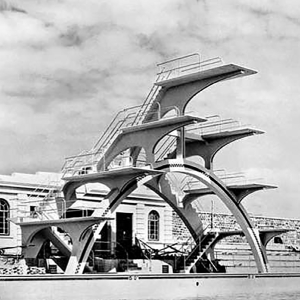Diving platforms as publicity objects of architectural expression during the 20th century
A transnational view of leisure culture
DOI:
https://doi.org/10.35305/23626097v11i20.453Keywords:
trampoline, leisure, publicity, State, modernityAbstract
This article intends to provide an account of design experiences concerning the construction of trampolines and diving platforms during the first decades of the twentieth century in the cities of Rio de Janeiro, Rome, and Weston-super-Mare. The link between these three latitudes and the projects undertaken in each of them lies in the promotion of landmarks of modernity to promote the new cultural patterns of leisure and entertainment of the time. These patterns led to the construction and dissemination of projects that served as objects of publicity attraction for the public administration. Within this context, widespread public access to swimming pools and spas enabled designers to explore various fields of formal expression through their works. The spatio-temporal contexts that facilitated these opportunities are emphasized examining both the technical features that gave rise to these works and the symbolic outcomes achieved.
Downloads
Metrics
References
Barros Correia, T. (2008). Art déco e indústria: Brasil, décadas de 1930 e 1940. Anais Do Museu Paulista: História E Cultura Material, 16(2), 47-104. Disponible en: https://doi.org/10.1590/S0101-47142008000200003
Feigel, L. (2012). Modernism on sea: Art and Culture at the British Seaside. En L. Feigel y A. Harris (Eds.), Kiss me quick: The aesthetics of excess in 1930s. Literature and Film (pp. 15-35).Oxford, UK: Editorial Peter Lang.
Gómez Alzate, A. (2010). El paisaje como patrimonio cultural, ambiental y productivo Análisis e intervención para su sostenibilidad. Kepes, 7(6), 91–106. Recuperado de https://revistasojs.ucaldas.edu.co/index.php/kepes/article/view/481
Gorelik, A. (1999), Tentativas de comprender una ciudad moderna. Block, 4, 62-78.
Gray, F. (2006). Designing the seaside. Architecture, society and nature. Londres, Gran Bretaña: Reaktion.
Gray, F. (2012). Modernism on sea: Art and Culture at the British Seaside. En L. Feigel y A. Harris (Eds.), 1930s. Architecture and the cult of the sun (pp. 159-179). Oxford, UK: Editorial Peter Lang.
Hölscher, T. (2022). El nadador de Paestum: Juventud, eros y mar en la antigua Grecia. Barcelona, España: Editorial Crítica.
Inaugurado festivamente o trampolín da Praia de Icarahy (17 de agosto de 1937). O Globo, p. 5. Disponible en: https://oglobo.globo.com/acervo/
Martinis, R. (2012). Pier Luigi Nervi in Argentina: elementi per la costruzione di una fama internazionale. G. Bianchino y D. Costi (Eds.), Cantiere Nervi. La costruzione di una identità. Storie, geografie, paralleli (pp. 236-240). Milán, Italia, Editorial Skira.
Mornati, S. (2007). Lo stabilimento balneare Kursaal di Lapadula e Nervi. Gruppo Mancosu Roma, Italia: Editore S.R.L.
Mornati, S. (2012). Castel Fusano e Cosenza. Nervi e le potenzialità del ferrocemento: tre opere. G. Bianchino y D. Costi (Eds.), Cantiere Nervi. La costruzione di una identità. Storie, geografie, paralleli (pp. 166-171). Milán, Italia, Editorial Skira.
The Fifth Olympiad: The Official Report of the Olympic Games of Stockholm, 1912. (1913) Estocolmo, Suecia: Wahlstrom & Windstrand Editores. Disponible en: https://archive.org/details/fiftholympiadoff00berg/page/1032/mode/2up
Trujano Filho, F. S (2018). Arquiteturas e Estado no Brasil de Vargas (1930-1945). Registros. Revista de Investigación Histórica, 14(2), 71-87.
Valcárcel, M. (2018). Una imagen invisible: la tumba del nadador. Disponible en: https://www.alejandradeargos.com/index.php/es/completas/8-arte/41615-la-tumba-del-nadador

Published
How to Cite
Issue
Section
License
Copyright (c) 2024 A&P Continuidad

This work is licensed under a Creative Commons Attribution-NonCommercial-ShareAlike 4.0 International License.
Open access policy
A&P Continuidad is a non-profit and open access publication. According to Mexico Declaration on Cultural Policies, the journal distribution is submitted to Creative Commons Attribution-Noncommercial-ShareAlike 4.0 International Public License (CC BY-NC-SA). “Neither the commercial use of the original work nor that of the possible derivative works are allowed. The distribution of derivative works should be submitted to the license regulating the original work. This license is not free.”
A&P Continuidad authorizes the partial or full reproduction of texts and graphs provided that the source is cited. Authors are exclusively responsible for the criteria expressed in the articles which do not necessarily reflect the opinion of the Editorial Committee or that of the Direction Board. The copyright of the published articles pertains to their authors or publishers.
Transfer of rights
The acceptance of an article to be published implies the author’s transfer of rights to the journal. Authors continue to have the right to use the material in future books or publications, approve or veto the republication of their works as well as the rights related to patents or other rights. Transfer of rights form may be downloaded here.























 This OJS site and its metadata are under a
This OJS site and its metadata are under a 

